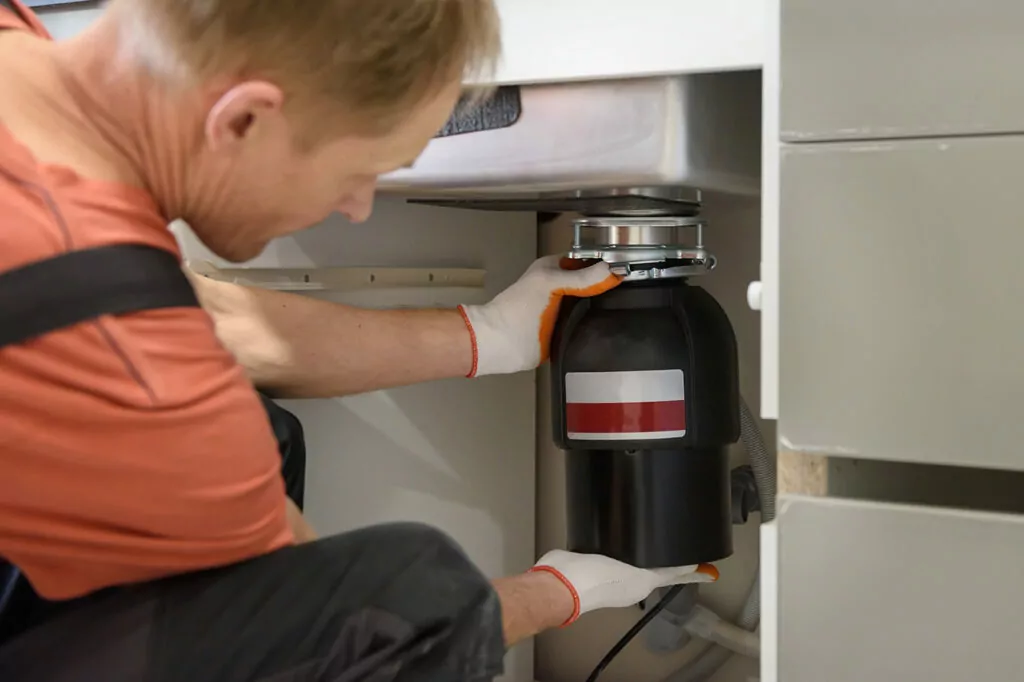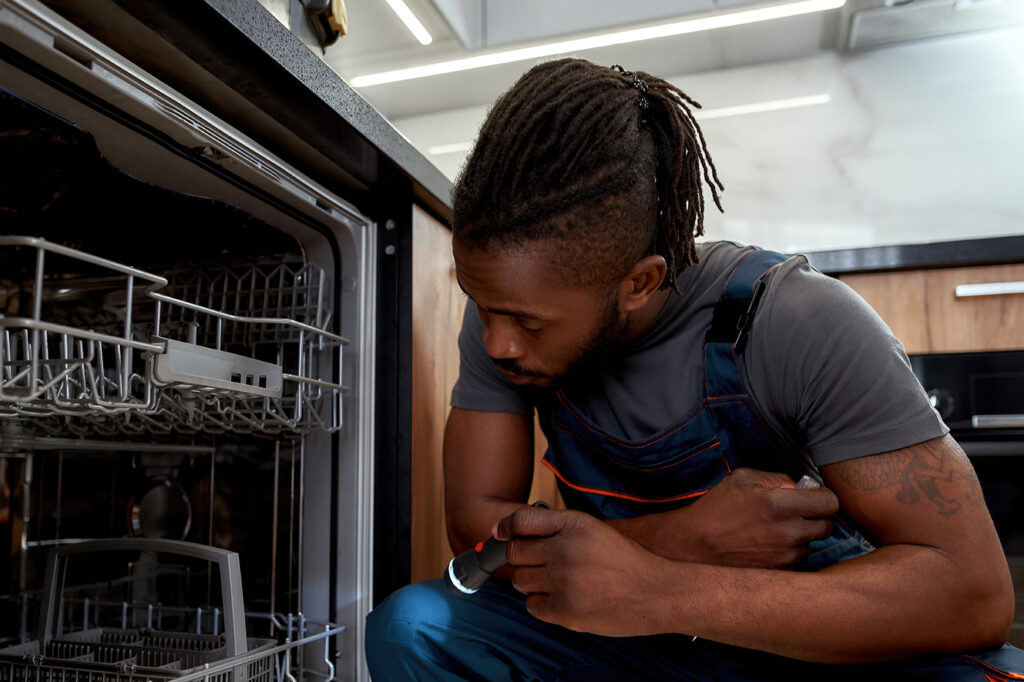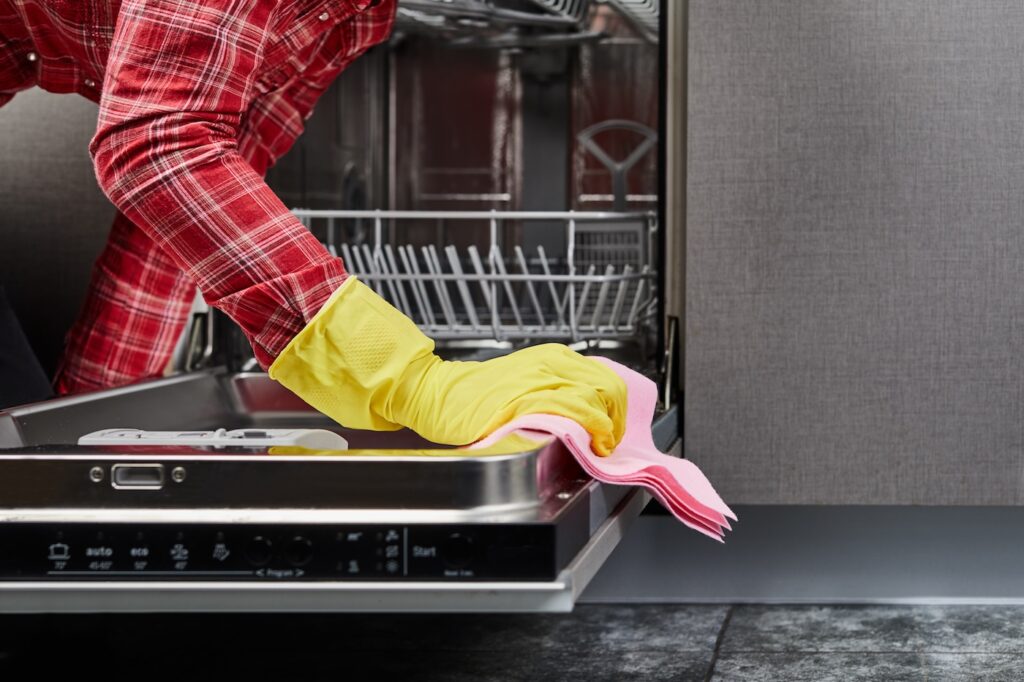Nothing can put a damper on doing the dishes quite like opening up your dishwasher after a cycle only to find a tub full of dirty, stagnant water. But don’t panic—a clogged dishwasher is a common problem that’s usually pretty easy for homeowners to fix. The key is figuring out what’s causing the blockage or drainage problems in the first place. Maybe some food scraps have worked their way into the drain, or perhaps you have a faulty drain pump on your hands. Luckily, there are some simple DIY troubleshooting steps—like rinsing the filter or clearing the drain hose—you can take to identify the clog and prevent the purchase of a new dishwasher. Let’s dive in and get to the bottom of this draining dilemma!
Why is My Dishwasher Not Draining?
1. Blocked Waste Disposal System

Dishwasher won’t drain? If the waste disposal system under your sink is clogged up, it can actually cause some major drainage issues. More specifically: The dishwasher’s drain line is often hooked up to share the same drain as the sink’s waste disposal. So if that disposal system gets backed up with last night’s spaghetti, it creates blockage. When the dishwasher tries to drain out the dirty wash water, it has nowhere to go because of that clogged disposal drain. Instead, the water just gets stuck in the dishwasher tub, leading to a puddle for your dishes to sit in.
2. Air Conduit Obstruction

Another culprit behind your dishwasher not draining completely is an obstructed air conduit. What does that mean exactly? Well, your dishwasher has an air conduit, which is a small tube or vent that allows air to flow in and out as the dishwasher drains. But if the conduit is obstructed, it creates a sort of suction that traps the water inside, instead of letting it flow smoothly down the drain.
3. Misaligned Sink Drain Loop

Your dishwasher’s drain hose is typically connected to the same drain as your kitchen sink. Now, that sink drain line is often routed in a looped shape under the cabinet—this is called the “drain loop.” The purpose of this loop is to create a natural trap that prevents dirty sink water and odors from flowing back into your dishwasher. But, if that drain loop gets bumped out of alignment or sags down too much, it can kink the hose and obstruct the flow, causing the water to back up and pool in the dishwasher tub instead of draining properly.
4. Incorrect Dishwasher Detergent

Dishwasher detergents are specially formulated to create just the right amount of suds and foam to clean your dishes properly. But the wrong kind of detergent—like using regular hand or dish soap instead of the recommended dishwasher detergent—can lead to an overly sudsy situation.
All those excess suds get trapped, preventing the water from draining out efficiently after a wash cycle leaving you with a tub full of dirty, sudsy water that just won’t drain.
5. Drain Basket Food Buildup

Most dishwashers have a small basket or filter located near the drain, designed to catch any leftover gunk as the water drains out. But over time, if that drain basket isn’t cleaned out regularly, the food buildup in there can become a major problem! All those bits of food and grime can end up forming a thick, stubborn clog that completely blocks the dishwasher’s drain so the water has nowhere to go.
6. Kinked Drain Hose

If your drain hose gets bent at a sharp angle or develops a kink, it creates a serious blockage that stops the water from flowing freely. You know what that means: That backed-up water has nowhere to go and pools in the tub. The good news? A simple straightening out can do the trick but be warned—once a drain hose kinks, it becomes more likely to kink again.
7. Blocked Drain Hose

Imagine trying to suck a thick milkshake through a straw that’s been stuffed with marshmallows—that’s kind of what’s happening when the dishwasher drain hose gets clogged up. The water just can’t make it through the blockage, so it ends up stuck and stagnating in the dishwasher tub. But breathe easy because unclogging that drain hose is usually a pretty straightforward fix.
Tools and Supplies to Unclog Dishwasher
To unclog your dishwasher, you’ll need the following tools and supplies:
- Bucket
- Towels
- Screwdriver
- Cup
- A toothbrush or soft-bristled brush
How to Unclog Dishwasher
Now that you have your tools and supplies, read ahead for the step-by-step guide to start unclogging your dishwasher.
1. Disconnect Dishwasher

First things first: Disconnect your dishwasher from the power before you start looking into why your dishwasher is not draining properly.
2. Empty the Dishwasher

Second: Open your dishwasher door and take out any plates, silverware, or other utensils so you can get a full look at what’s going on inside.
3. Remove Standing Water

Next, you’re going to want to remove any standing water in the dishwasher. Pull out the bottom rack and then place your towels at the bottom of the dishwasher to sop up any remaining water. If there’s a ton of standing water, you can use a cup to scoop out the water into your bucket first.
4. Remove and Rinse the Dishwasher Filter

First, locate the filter inside your dishwasher. It’s usually found at the bottom of the tub, either in the center or along the side—just take a peek around and you should spot it. Now, carefully remove the filter, which may require twisting or unscrewing with a screwdriver. Tip: Go slowly and avoid forcing anything, you don’t want to damage the filter or dishwasher.
With the filter out, give it a good rinse under running water. Use your hands or a soft-bristle brush to scrub away any built-up food debris, grime, or mineral deposits that may be clogging it up. Once it’s nice and clear, simply pop the filter back into its place in the dishwasher. Make sure it’s securely locked back into position.
5. Check the Garbage Disposal and Air Gap Cylinder

If the dishwasher drain is connected to the disposal, any blockages or clogs in the disposal can definitely cause drainage issues. Try running the disposal to see if it’s working properly—if it’s jammed or not spinning freely, you may need to reset or unclog the disposal before the dishwasher will drain correctly.
Next, check the air gap cylinder. This is a small chrome or plastic cylinder, often located on the counter near the sink, that’s part of the dishwasher’s drainage system. Its job is to prevent dirty dishwater from backing up into the clean water supply. Make sure the air gap cylinder is clear of any clogs or blockages by giving it a clean and then reconnecting it. If the air gap appears damaged or isn’t functioning properly, you may need to replace it.
6. Check the Drain Motor, Drain Valve, and Drain Hose

Take a look at the drain motor. This is the component responsible for actively pumping the dirty water out of the dishwasher tub. If the drain motor is faulty or not running properly, it can prevent the water from draining efficiently.
Next, examine the drain valve. This is a small valve that opens and closes to control the flow of water out of the dishwasher. Try manually opening and closing the drain valve to see if it’s operating smoothly. If it seems stuck or damaged, you may need to replace it.
And finally, don’t forget to thoroughly inspect the drain hose. This is the flexible pipe that carries the dirty water from the dishwasher out to your home’s main plumbing. Check for any kinks, cracks, or clogs that could be obstructing the flow. If the hose is in good shape, you can try clearing out any built-up debris. But if it’s damaged, you’ll likely need to replace the hose to get your dishwasher draining properly again.
Frequently Asked Questions
How do I force my dishwasher to drain?
Try pressing and holding the “cancel” button on your dishwasher for three seconds (or whatever time your model’s instructions advise). Once the water stops running, it should drain.
How do I know if my dishwasher drain hose is clogged?
You can tell if your dishwasher drain hose is clogged if you open your dishwasher door and there’s standing water on the bottom of your dishwasher.
How do you flush a dishwasher?
A great way to flush dishwater is by filling a bowl with 1 cup of distilled white vinegar and placing it on the top dishwasher rack. Then, run a heavy rinse cycle with no detergent or dishes inside.
Do all dishwashers have a drain valve?
No, not all dishwashers have a drain valve. But if your dishwasher does, then you might want to check to see if it’s causing an issue.
Call for Help
While a dishwasher that isn’t draining can be a DIY job—whether that’s using the right dishwasher detergent or clearing out food buildup—sometimes, you need a little assistance. That’s where Taskrabbit’s Home Improvements services come in handy. From leaking garbage disposals to a dishwasher deep-clean to full-on appliance repair, Taskers have your back.














